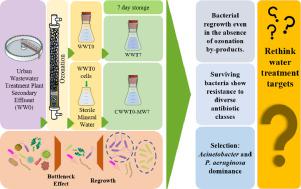Water Research ( IF 11.4 ) Pub Date : 2021-06-17 , DOI: 10.1016/j.watres.2021.117374 Nuno F F Moreira 1 , Sara Ribeirinho-Soares 2 , Ana Teresa Viana 2 , Cátia A L Graça 3 , Ana Rita L Ribeiro 3 , Nadine Castelhano 4 , Conceição Egas 5 , M Fernando R Pereira 3 , Adrián M T Silva 3 , Olga C Nunes 2

|
Ozonation is among the currently used technologies to remove chemical and biological contaminants from secondary treated urban wastewater (UWW). Despite its effectiveness on the abatement of organic micropollutants (OMPs) and disinfection, previous studies have shown that regrow of bacteria may occur upon storage of the ozonated UWW. This reactivation has been attributed to the high content of assimilable organic carbon after treatment. In order to investigate if ozonation by-products are the main biological regrowth drivers in stored ozonated UWW, the ozonation surviving cells were resuspended in sterile bottled mineral water (MW), simulating a pristine oligotrophic environment. After 7 days storage, organisms such as Acinetobacter, Methylobacterium, Cupriavidus, Massilia, Acidovorax and Pseudomonas were dominant in both ozonated UWW and pristine MW, demonstrating that bacterial regrowth is not strictly related to the eventual presence of ozonation by-products, but instead with the ability of the surviving cells to cope with nutrient-poor environments. The resistome of UWW before and after ozonation was analysed by metagenomic techniques. Draft metagenome assembled genomes (dMAGs), recovered from both ozonated UWW and after cell resuspension in MW, harboured genes conferring resistance to diverse antibiotics classes. Some of these antibiotic resistance genes (ARGs) were located in the vicinity of mobile genetic elements, suggesting their potential to be mobilized. Among these, dMAGs affiliated to taxa with high relative abundance in stored water, such as P. aeruginosa and Acinetobacter spp., harboured ARGs conferring resistance to 12 and 4 families of antibiotics, respectively, including those encoding carbapenem hydrolysing oxacillinases.
The results herein obtained point out that the design and development of new wastewater treatment technologies should include measures to attenuate the imbalance of the bacterial communities promoted by storage of the final treated wastewater, even when applying processes with high mineralization rates.
中文翻译:

重新思考水处理目标:细菌在无法证实的条件下重新生长
臭氧化是目前用于从二级处理城市废水 (UWW) 中去除化学和生物污染物的技术之一。尽管它对减少有机微污染物 (OMP) 和消毒很有效,但先前的研究表明,在臭氧化 UWW 的储存过程中可能会发生细菌的再生。这种再活化归因于处理后高含量的可同化有机碳。为了研究臭氧化副产品是否是储存的臭氧化 UWW 中的主要生物再生长驱动因素,将臭氧化存活的细胞重新悬浮在无菌瓶装矿泉水 (MW) 中,模拟原始的寡营养环境。储存 7 天后,诸如不动杆菌属、甲基杆菌属、Curiavidus、Massilia、Acidovorax 和假单胞菌在臭氧化 UWW 和原始 MW 中均占优势,表明细菌再生与臭氧化副产物的最终存在并不严格相关,而是与存活细胞应对营养贫乏环境的能力有关。通过宏基因组技术分析了臭氧化前后UWW的抗性组。宏基因组组装基因组草案 (dMAGs) 从臭氧化的 UWW 和细胞重悬后 MW 中回收,其中包含赋予对多种抗生素类别的抗性的基因。其中一些抗生素抗性基因 (ARG) 位于可移动遗传元件附近,表明它们具有被动员的潜力。其中,dMAGs 隶属于存储水中相对丰度较高的类群,如铜绿假单胞菌和Acinetobacter spp. 携带的 ARGs 分别赋予 12 和 4 类抗生素抗性,包括编码碳青霉烯水解苯唑西林酶的那些。
此处获得的结果指出,新废水处理技术的设计和开发应包括减轻最终处理废水储存所促进的细菌群落失衡的措施,即使在应用高矿化率的工艺时也是如此。











































 京公网安备 11010802027423号
京公网安备 11010802027423号